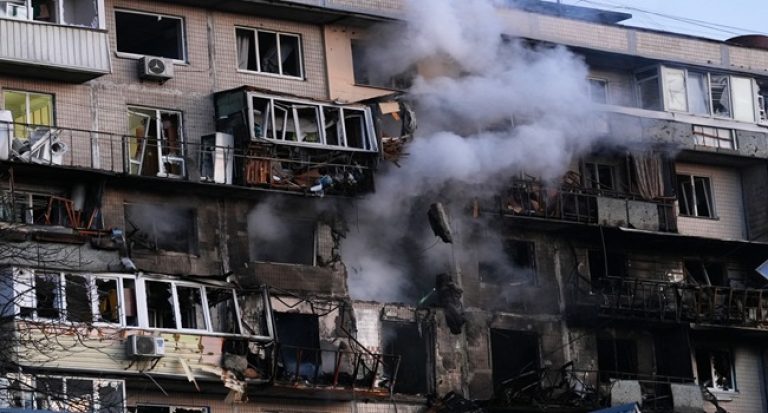
Some people wear masks as they walk by the entrance to the Yaounde General Hospital in Yaounde on March 6, 2020 as Cameroon has confirmed its first case of the COVID-19 coronavirus, a French national who arrived in the capital Yaounde in February, the government said on today. - The man, 58, has been placed in isolation in a hospital, the health ministry said in a statement. In sub-Saharan Africa, Senegal has registered four cases, all foreign nationals, and South Africa and Nigeria have one case each since the outbreak emerged in December in China. (Photo by - / AFP)
Reports of COVID-19 cases are growing on university campuses as schools reopen for the fall semester.
The University of North Carolina at Chapel Hill quickly reversed its in-person classes as 135 positive COVID-19 cases, 130 students and five employees emerged after the first week of classes from Aug. 10 to Aug. 16.
“We have seen COVID-19 positive rate rise from 2.8% to 13.6% at Campus Health,” stated a letter posted on Monday to the university’s website.
Almost 1,000 (954) students have been tested, 177 are in isolation and 349 are in quarantine, both on and off campus, according to the letter. The university will shift all undergraduate in-person instruction to remote learning, effective Wednesday, Aug. 19.
Oklahoma State University announced Aug. 15 there were 23 positive COVID cases in an off-campus sorority house. The entire house is in isolation or quarantine and will be prohibited from leaving the facility.
The University of Wyoming also reported Monday 38 active cases among students and staff.
Two involve students living in the university’s residence halls, and the other 36 cases involve students and employees living off campus. Both groups are in isolation.
Boston University’s ‘COVID-19 Testing Data Dashboard’ showed eight positive tests cumulative from July 27.
The University of Notre Dame in Indiana also saw a spike in COVID-19 cases, reporting 59 confirmed positive cases out of 654 total tests since Aug. 3.
Notre Dame officials stated in a letter, “the vast majority of the positive cases appearing in the university’s dashboard this week can be traced to a SINGLE off-campus gathering.”
“The students involved were forthcoming in sharing information with contact tracers. They shared who they interacted with, when and for how long. They also indicated individuals at the gathering were both outside and inside, together for some time, not wearing masks, in a crowded space, and drinking,” it continued.
A New York Times survey of 270 higher education institutions uncovered 6,600 COVID-19 infections among students and staff, as well as 14 coronavirus-related deaths over the course of the pandemic.
In the list, the University of Texas at Austin recorded the most positive cases, with 449 from March 1 to July 28.
University of Central Florida came in second with 438 cases, and University of Georgia recorded 390.
Although many colleges and universities offer comprehensive reopening plans with mask-wearing and social distancing guidelines, research shows that even with such reinforcements the virus would still roam throughout campuses, causing complications.
Philip Gressman, a professor of mathematics at the University of Pennsylvania, and Jennifer Peck, an economics professor at Swarthmore College, created a simulation to “determine whether in-person instruction could safely continue during the pandemic and evaluate the necessity of various interventions.”
The simulation studied the spread of a highly transmissible virus, such as COVID-19, at reasonably large research university and monitored the efficacy of interventions, such as contact tracing, mask-wearing, online instruction, etc.
It consisted of 20,000 students and 2,500 instructors who interacted daily for 100 days.
The results of Gressman and Peck’s model analyzed that a scenario with no interventions from the university would result in the number of people initially infected doubling every 2.185 days.
In other words, more than 2,000 people would be infected within 30 days of the first infection, and about 20,126 people, or 89.4% of the total campus population, would end up infected.
The model also studied the outcome of standard intervention, which would be a combination of quarantine and contact tracing, universal mask-wearing, daily randomized testing of 3% of the university community, and transitioning all classes with 30 or more students to online-only interaction.
Full standard intervention measures in universities “avoid the epidemic tipping point altogether” and keeps cumulative infections below 66 (out of 22,500) in more than 95% of simulations, according to the study.
Gressman and Peck wrote that allowing large in-person courses would increase infections from 43 to 538, and online classes with more than 30 students was the most effective at keeping infection rates low.
Requiring masks was moderately effective: not requiring masks would increase median infections to 131, they wrote. Random testing and contact tracing had the lowest impact, with removing either measures increasing infections to 50 and 47, respectively.
Researchers Kim Weeden and Benjamin Cornwell from Cornell University in New York analyzed how students are interconnected on a college campus and the implications of resuming in-person instruction during the coronavirus pandemic.
Weeden and Cornwell’s study stated that students are “highly interconnected” through their courses and that the nature of enrollment networks makes student populations susceptible to high rates of transmissions. (VOA)








627362 242934Hey there, Can I copy this post image and implement it on my private internet log? 835577